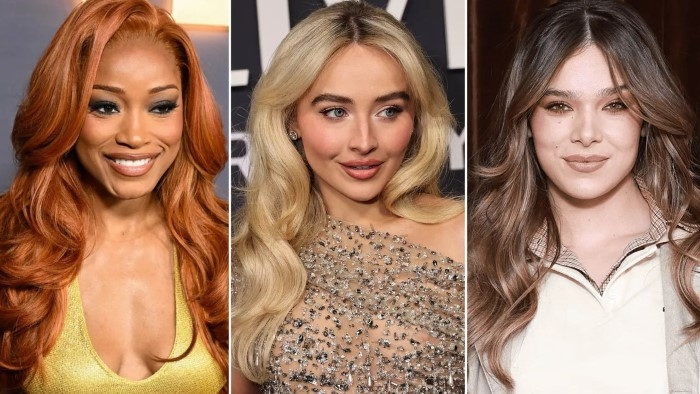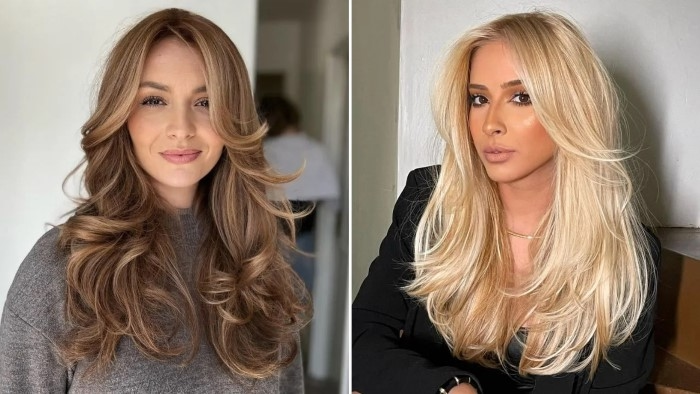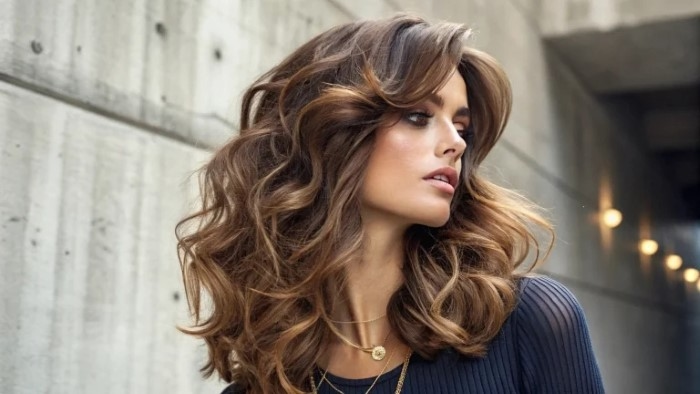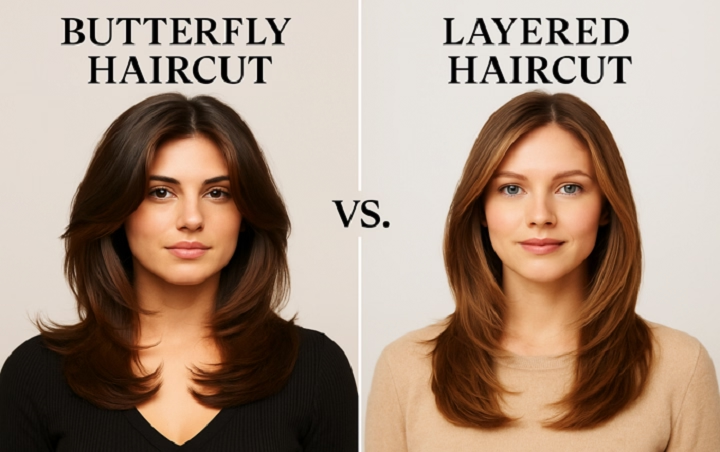You’re scrolling, saving, second-guessing. Do you want lift and wings? Or simple movement and an easy grow-out? That’s the heart of butterfly cut vs layers. One is architecture with a flourish. The other is the classic you can wear a hundred ways. In the next few minutes, we’ll compare them clearly—shape, vibe, upkeep, face-shape tuning, texture tweaks, and real-life routines. By the end, the butterfly cut vs layers question won’t feel like a guessing game. It’ll feel like a choice you make with confidence.
What Each One Is—In Plain English
Butterfly Cut: Movement with a Message
Rounded layers at the crown for lift. Face-framing pieces that sweep outward like wings. Length that stays, ends that feel protected. It looks polished even when you only had five minutes. It’s softer than a shag, kinder than a wolf cut, and more intentional around the face.
Classic Layers: The Versatile Foundation
Layers that reduce weight and add motion through the lengths. No required wings. No mandated crown lift. Classic layers can be subtle or dramatic, long or short, face-framing or not. They’re the blank canvas of haircuts.
Butterfly Cut vs Layers: The Snapshot You Wanted

- Vibe
- Butterfly: soft glam, light around the eyes, quietly camera-ready.
- Layers: flexible mood—boho, sleek, sporty, or elegant depending on styling.
- Butterfly: soft glam, light around the eyes, quietly camera-ready.
- Architecture
- Butterfly: outward wings + gentle crown elevation, preserved perimeter.
- Layers: distributed movement; emphasis shifts with where layers start.
- Butterfly: outward wings + gentle crown elevation, preserved perimeter.
- Effort
- Butterfly: two front rollers or a quick round-brush pass create wings.
- Layers: brush and go, scrunch and diffuse, or full blowout—your call.
- Butterfly: two front rollers or a quick round-brush pass create wings.
- Grow-Out
- Butterfly: glides from “fresh” to “soft” while the wings mellow.
- Layers: famously forgiving; the shape just settles and stays friendly.
- Butterfly: glides from “fresh” to “soft” while the wings mellow.
Keep this snapshot in mind as we keep saying it: butterfly cut vs layers is really about energy vs elasticity—statement wings vs universal motion.
Face-Shape Tuning (So Features Sing, Not Struggle)
Round Face
- Butterfly: a touch more crown height; wings start below the cheekbone. Elongates and slims.
- Layers: start face-framing at cheek or slightly below; avoid heavy volume at the widest point.
Oval Face
- Butterfly: choose cheekbone wings for drama or lip-skimming for romance.
- Layers: you can do almost anything; balance is built in.
Square Face
- Butterfly: feather inward at the jaw, then arc outward; softens angles without losing strength.
- Layers: long layers with curved face-framing; avoid bluntness near the jawline.
Heart Face
- Butterfly: fuller frame near the chin; wings that land at or just below the jaw.
- Layers: add weight toward the ends so the look feels harmonious.
Long or Rectangular Face
- Butterfly: modest crown lift; wider cheek-level frame to shorten the canvas.
- Layers: begin face-framing higher at the cheeks; keep overall silhouette wider, not taller.
In short: butterfly cut vs layers both adapt to every face—placement is everything.
Butterfly Cut vs Layers: Texture & Density

Straight Hair
- Butterfly: crisp wings, glossy lines, quick to set with two rollers.
- Layers: clean drape; go subtle for sleek days or steeper for volume.
Wavy Hair
- Butterfly: S-curves echo the wings naturally; minimal effort looks “done.”
- Layers: waves bloom; long layers prevent triangle shape and keep length swishy.
Curly Hair
- Butterfly: yes—with intention. Longer face pieces preserve spring; sculpt curl-by-curl near the face.
- Layers: essential for shape control; cut with shrinkage in mind and keep the perimeter even.
Coily Hair
- Butterfly: hydrate, protect ends, lengthen wings slightly for outward motion without jump.
- Layers: create vertical balance and reduce bulk while honoring coil patterns.
Fine or Low Density
- Butterfly: protect the last inch; minimal end-thinning; foam for lift.
- Layers: choose fewer, longer layers to keep fullness. Avoid shredding the hemline.
Thick or High Density
- Butterfly: internal debulking; slightly longer wings for soft swing.
- Layers: remove weight where hair stacks (under the crown, behind the ears). Keeps the ends substantial.
This is where butterfly cut vs layers becomes tactical: both can flatter every texture if you respect density, shrinkage, and how you actually style.
Styling: Fast, Real, Repeatable
Butterfly: 6–8 Minute Blowout
- Heat protectant everywhere; root-lifting foam at the crown.
- Rough-dry to 80%.
- Round-brush the front away from the face to set wings.
- Pop two Velcro rollers at the crown while you get ready.
- Release, finger-comb, a whisper of cream on ends, flexible spray.
Butterfly: Heatless Wings
- Mist front + crown.
- Two large rollers on the face frame, one at the crown.
- Makeup. Coffee. Remove. Go.
Layers: One-Brush Polish
- Heat protectant; blow-dry with a paddle or round brush, curving the ends.
- Optional: bend the front pieces for soft framing.
Layers: Air-Dry Flow
- Leave-in + light cream; scrunch or brush smooth.
- Clip the crown for ten minutes while drying if you want to lift.
When it’s butterfly cut vs layers in the morning rush, wings reward tiny, targeted effort; layers reward whatever time you have—little or lots.
Butterfly Cut vs Layers: Maintenance, Trims and Real Grow Out

- Butterfly: trims every 8–10 weeks; refresh shorter face pieces at 4–6 if you wear them.
- Layers: 8–12 weeks depending on hair health and how dramatic your layers are.
Both grow out kindly. The difference? In butterfly cut vs layers, wings will soften first; layered ends just keep drifting in a friendly, wearable way.
Color Pairings That Amplify Shape
- Butterfly: face-framing lights one to two levels brighter; gloss for shine so wings catch the light.
- Layers: ribbons of balayage emphasize movement; a clear glaze revives drape.
Color is optional. Shine is essential.
Salon Scripts (Use These Words)
If You’re Leaning Butterfly
“I want a butterfly cut with rounded crown lift and outward face-framing pieces. Please protect the last inch, remove bulk internally, and keep the perimeter ponytail-friendly. Cut for my routine—mostly heatless/quick blowout. Dry check at my real part.”
If You’re Leaning Classic Layers
“I want long layers that add movement without thinning my ends too much. Light face-framing that starts at (cheek/lip). Please reduce weight where my hair stacks and keep the hemline substantial. Cut for air-dry/diffuser/quick brush. Dry check at my real part.”
The clearer the script, the better the result. In butterfly cut vs layers, language is your lever.
Common Mistakes—and Kind Fixes
- Wings cut too short (butterfly). Start at cheek or lip; refine next visit.
- Over-thinned ends (both). Remove bulk higher up; keep the last inch.
- Ignoring your real part (both). Always request a dry check at your everyday part.
- Heavy oils everywhere (both). Micro-dose on tips only; weight kills lift and motion.
- Chasing volume with product instead of architecture (both). Ask for the shape that does the work, then use light products to support it.
Five-Day Plans You’ll Actually Follow
Butterfly Week
- Day 1: Quick blowout; crown rollers.
- Day 2: Dry shampoo; one front roller while you sip coffee.
- Day 3: Water mist + foam at crown; two-second round-brush pass on wings.
- Day 4: Brush-out; flat-iron tap just the face pieces for the outward arc.
- Day 5: Low clip; let the wings fall loose.
Layers Week
- Day 1: Brush-blowout or diffuse to taste.
- Day 2: Dry shampoo; touch up the front only.
- Day 3: Air-dry refresh with leave-in; crown clip ten minutes.
- Day 4: Curl two or three sections near the face, brush through.
- Day 5: Braid, pony, or claw clip—layers keep the outline soft.
Butterfly cut vs layers isn’t about “hard vs easy.” It’s about where a little effort makes the biggest impact.
Work, Weekends, Photos: Where They Shine
- Butterfly: Zoom frames the eyes; wings do the rest. Dinner selfies look intentional with minimal prep.
- Layers: Gym to office to dinner. You can pivot the vibe with a brush, a scrunch, or a clip.
Ask yourself: where does your week live? That’s where the butterfly cut vs layers choice becomes obvious.
Real-World Examples (Imagine Yourself Here)
- Busy professional on camera: butterfly for built-in frame, quick revival with two rollers.
- Gym before office, air-dry loyalist: layers for adaptable motion and easy tie-backs.
- Fine hair, seeks fullness: butterfly with protected ends; or long layers with barely-there texturizing—either way, guard the hemline.
- Thick, heavy hair, needs relief: both; choose the vibe you love and ask for internal debulking.
The right answer to butterfly cut vs layers is the one that supports your mornings and respects your texture.
FAQs
Is a butterfly cut high maintenance compared to layers?
Not really. Wings revive fast with two rollers or a quick brush pass. Layers are flexible too; both can be low-effort if cut for your routine.
Which is better for fine hair?
Both work when ends are protected. Butterfly adds crown lift and face framing; subtle long layers preserve fullness and swing.
Can curly hair wear either?
Yes. Butterflies need longer face pieces to account for shrinkage. Layers should be cut curl-by-curl with an even perimeter.
What if I change my mind later?
Layers and butterflies both grow out kindly. Butterfly wings soften; layered lengths settle. Micro-trims keep the journey graceful.
How do I explain my choice at the salon?
Bring photos that match your texture and part, then use the scripts above. Ask for a dry check at your real part. Placement is everything.
Hair is a mood you can touch. Some days ask for wings. Others ask for quiet movement. Butterfly cut vs layers isn’t a fight; it’s a conversation with your life. Choose the shape that lets you breathe, that meets your morning, that flatters your features when you turn your head toward the light. Then keep your ends protected, your part honest, and your products light. The rest is rhythm.

